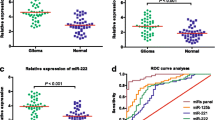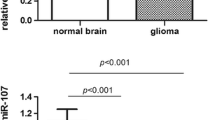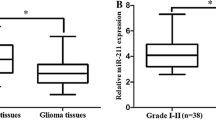Abstract
Glioma is the most common type of primary malignant tumor in the central nervous system (CNS) with a high incidence and a high mortality rate, as well as an extremely low 5-year survival rate. As a class of small non-coding RNAs, microRNAs (miRNAs) may be closely involved in carcinogenesis and might also be connected with glioma diagnosis and prognosis. In this study, we aimed at investigating the expression level of microRNA-183 (miR-183) in 105 cases of glioma tissues of four World Health Organization (WHO) grades and 10 cases of normal brain tissues and its potential predictive and prognostic values in glioma. We found that the expression levels of miR-183 were significantly higher in glioma tissues than that in normal brain tissues, and also higher in high-grade gliomas (WHO grade III and IV) compared with low-grade gliomas (WHO grade I and II). The miR-183 expression level was classified as low or high according to the median value. High expression of miR-183 was found to significantly correlate with larger tumor size, higher WHO grade, and worse Karnofsky performance score (KPS). Kaplan–Meier survival analysis showed that patients with high miR-183 expression had worse overall survival (OS) and progression-free survival (PFS) than patients with low miR-183 expression. Moreover, univariate and multivariate analyses indicated that miR-183 expression level was an independent prognostic parameter of a patient’s OS and PFS. In conclusion, our study indicated that miR-183 was upregulated in glioma, and that it may be used as a potential biomarker of poor prognosis in patients with glioma.


Similar content being viewed by others
References
McCarthy BJ, Shibui S, Kayama T, Miyaoka E, Narita Y, Murakami M et al (2012) Primary CNS germ cell tumors in Japan and the United States: an analysis of 4 tumor registries. Neuro Oncol 14:1194–1200
Furnari FB, Fenton T, Bachoo RM, Mukasa A, Stommel JM, Stegh A et al (2007) Malignant astrocytic glioma: genetics, biology, and paths to treatment. Genes Dev 21:2683–2710
Meyer MA (1850) Malignant gliomas in adults. N Engl J Med 2008(359):1850
Zhang X, Yang H, Gong B, Jiang C, Yang L (2012) Combined gene expression and protein interaction analysis of dynamic modularity in glioma prognosis. J Neurooncol 107:281–288
Liang Z, Gao Y, Shi W, Zhai D, Li S, Jing L et al (2013) Expression and significance of microRNA-183 in hepatocellular carcinoma. Sci World J 2013:1–6
Yates LA, Norbury CJ, Gilbert RJ (2013) The long and short of microRNA. Cell 153:516–519
Uchino K, Ochiya T, Takeshita F (2013) RNAi therapeutics and applications of microRNAs in cancer treatment. Jpn J Clin Oncol 43:596–607
Wang G, Mao W, Zheng S (2008) MicroRNA-183 regulates Ezrin expression in lung cancer cells. FEBS Lett 582:3663–3668
Lowery AJ, Miller N, Dwyer RM, Kerin MJ (2010) Dysregulated miR-183 inhibits migration in breast cancer cells. BMC Cancer 10:502
Cao LL, Xie JW, Lin Y, Zheng CH, Li P, Wang JB et al (2014) MiR-183 inhibits invasion of gastric cancer by targeting Ezrin. Int J Clin Exp Pathol 7:5582–5594
Sarver AL, Li L, Subramanian S (2010) MicroRNA miR-183 functions as an oncogene by targeting the transcription factor EGR1 and promoting tumor cell migration. Cancer Res 70:9570–9580
Bartel DP (2004) MicroRNAs: genomics, biogenesis, mechanism, and function. Cell 116:281–297
Lin S, Gregory RI (2015) MicroRNA biogenesis pathways in cancer. Nat Rev Cancer 15:321–333
Esquela-Kerscher A, Slack FJ (2006) Oncomirs—microRNAs with a role in cancer. Nat Rev Cancer 6:259–269
Schetter AJ, Leung SY, Sohn JJ, Zanetti KA, Bowman ED, Yanaihara N et al (2008) MicroRNA expression profiles associated with prognosis and therapeutic outcome in colon adenocarcinoma. JAMA 299:425–436
Yu SL, Chen HY, Chang GC, Chen CY, Chen HW, Singh S et al (2008) MicroRNA signature predicts survival and relapse in lung cancer. Cancer Cell 13:48–57
Iorio MV, Ferracin M, Liu CG, Veronese A, Spizzo R, Sabbioni S et al (2005) MicroRNA gene expression deregulation in human breast cancer. Cancer Res 65:7065–7070
Ciafre SA, Galardi S, Mangiola A, Ferracin M, Liu CG, Sabatino G et al (2005) Extensive modulation of a set of microRNAs in primary glioblastoma. Biochem Biophys Res Commun 334:1351–1358
Lu J, Getz G, Miska EA, Alvarez-Saavedra E, Lamb J, Peck D et al (2005) MicroRNA expression profiles classify human cancers. Nature 435:834–838
Bastian BC, LeBoit PE, Hamm H, Brocker EB, Pinkel D (1998) Chromosomal gains and losses in primary cutaneous melanomas detected by comparative genomic hybridization. Cancer Res 58:2170–2175
Zhao H, Guo M, Zhao G, Ma Q, Ma B, Qiu X et al (2012) MiR-183 inhibits the metastasis of osteosarcoma via downregulation of the expression of Ezrin in F5M2 cells. Int J Mol Med 30:1013–1020
Hunter KW (2004) Ezrin, a key component in tumor metastasis. Trends Mol Med 10:201–204
Xu L, Li Y, Yan D, He J, Liu D (2014) MicroRNA-183 inhibits gastric cancer proliferation and invasion via directly targeting Bmi-1. Oncol Lett 8:2345–2351
Li J, Fu H, Xu C, Tie Y, Xing R, Zhu J et al (2010) MiR-183 inhibits TGF-beta1-induced apoptosis by downregulation of PDCD4 expression in human hepatocellular carcinoma cells. BMC Cancer 10:354
Zhang H, Ozaki I, Mizuta T, Hamajima H, Yasutake T, Eguchi Y et al (2006) Involvement of programmed cell death 4 in transforming growth factor-beta1-induced apoptosis in human hepatocellular carcinoma. Oncogene 25:6101–6112
Bohm M, Sawicka K, Siebrasse JP, Brehmer-Fastnacht A, Peters R, Klempnauer KH (2003) The transformation suppressor protein Pdcd4 shuttles between nucleus and cytoplasm and binds RNA. Oncogene 22:4905–4910
Jansen AP, Camalier CE, Colburn NH (2005) Epidermal expression of the translation inhibitor programmed cell death 4 suppresses tumorigenesis. Cancer Res 65:6034–6041
Lu YY, Zheng JY, Liu J, Huang CL, Zhang W, Zeng Y (2015) MiR-183 induces cell proliferation, migration, and invasion by regulating PDCD4 expression in the SW1990 pancreatic cancer cell line. Biomed Pharmacother 70:151–157
Wei C, Song H, Sun X, Li D, Song J, Hua K et al (2015) MiR-183 regulates biological behavior in papillary thyroid carcinoma by targeting the programmed cell death 4. Oncol Rep 34:211–220
Zhang L, Quan H, Wang S, Li X, Che X (2015) MiR-183 promotes growth of non-small cell lung cancer cells through FoxO1 inhibition. Tumour Biol 36:8121–8126
Tang H, Bian Y, Tu C, Wang Z, Yu Z, Liu Q et al (2013) The miR-183/96/182 cluster regulates oxidative apoptosis and sensitizes cells to chemotherapy in gliomas. Curr Cancer Drug Targets 13:221–231
Zhang Z, Li S, Cheng SY (2013) The miR-183 approximately 96 approximately 182 cluster promotes tumorigenesis in a mouse model of medulloblastoma. J Biomed Res 27:486–494
Tanaka H, Sasayama T, Tanaka K, Nakamizo S, Nishihara M, Mizukawa K et al (2013) MicroRNA-183 upregulates HIF-1alpha by targeting isocitrate dehydrogenase 2 (IDH2) in glioma cells. J Neurooncol 111:273–283
Targeting Semenza GL (2003) HIF-1 for cancer therapy. Nat Rev Cancer 3:721–732
Semenza GL (2010) HIF-1: upstream and downstream of cancer metabolism. Curr Opin Genet Dev 20:51–56
Zhou T, Zhang GJ, Zhou H, Xiao HX, Li Y (2014) Overexpression of microRNA-183 in human colorectal cancer and its clinical significance. Eur J Gastroenterol Hepatol 26:229–233
Ueno K, Hirata H, Shahryari V, Deng G, Tanaka Y, Tabatabai ZL et al (2013) MicroRNA-183 is an oncogene targeting Dkk-3 and SMAD4 in prostate cancer. Br J Cancer 108:1659–1667
Acknowledgments
This study was supported by National Natural Science Foundation of China (Nos. 81371294, 81401026, 81400980 and 81401029) and Jiangsu Provincial Natural Science Foundation of China (No. BK20141375).
Author information
Authors and Affiliations
Corresponding authors
Ethics declarations
Conflict of interest
The authors declare that they have no conflict of interest.
Ethical approval
All procedures performed in studies involving human participants were in accordance with the ethical standards of the institutional and/or national research committee and with the 1964 Helsinki declaration and its later amendments or comparable ethical standards.
Additional information
Z. Ye and Z. Zhang contributed equally to this work.
Rights and permissions
About this article
Cite this article
Ye, Z., Zhang, Z., Wu, L. et al. Upregulation of miR-183 expression and its clinical significance in human brain glioma. Neurol Sci 37, 1341–1347 (2016). https://doi.org/10.1007/s10072-016-2599-5
Received:
Accepted:
Published:
Issue Date:
DOI: https://doi.org/10.1007/s10072-016-2599-5




